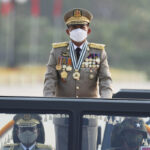
Destroyed tanks and body parts are all that are left of a Russian advance, part of the larger battle to block the invaders’ attempt to enter or encircle the capital.
NORTHERN OUTSKIRTS OF KYIV, Ukraine — When Ukrainian forces hit a Russian tank with an American-made Javelin missile on a highway on the northern reaches of the capital, Kyiv, the explosion was so huge that it tossed the turret 10 yards down the road and shredded the rest of the vehicle and the men inside.
The charred body parts of Russian soldiers were still decomposing on the asphalt three weeks later, alongside scattered metal debris and ammunition. A single felt boot, favorite footwear for centuries in Russia’s frozen villages, lay blackened among the detritus.
“Good shot,” the Ukrainian commander said with elation, surveying the wreck. A deputy commander of the 72nd Mechanized Brigade, which controlled the area, he asked that he be identified only by his nom de guerre, Sulim. He pointed to blackened chunks of human flesh and bone on the road from Russian soldiers killed in the strike, and added, “It was all humane, it was all very quick.”
“They came four times,” Commander Sulim, 40, said. “Let them come again. I am waiting.”
The Russian Army has come, again and again, trying to penetrate villages and suburbs around Kyiv for weeks, in what has become a seesaw battle for the critical areas that could be used to enter or encircle and eventually shell the capital.
Ukrainian media officers escorted several teams of journalists on a rare visit through villages close to Russian lines in the countryside of greater Kyiv on Friday to show some of the damage from early fighting, as well as the success of the Ukrainian resistance and the counterattacks Ukraine’s military has mounted.
The villages visited were not among those recently liberated by the continuing Ukrainian counteroffensive, but they had come under attack as Russian forces had tried to seize them two weeks ago. Similar battles are now being waged daily.
This spot on the edge of a village, on a highway leading into Kyiv, marked the limit of the Russian advance in the area under Commander Sulim’s watch. Two tanks — a T-90 that was hit by the Javelin and a T-72 — according to the commander, were ambushed on the road on March 2 during the first week of the war. A half-dozen burned-out armored vehicles lay nearby — beside a cluster of houses and in a gully — wrecks from several skirmishes over the period of a week.
Russian forces were still just four miles away, but the commander asked that the village names not be published to safeguard his positions.
The villages on the front line were mostly deserted, with just a few men and women guarding houses and looking after their livestock. The first line of houses facing the road where the tank battle happened were badly damaged from artillery or tank shells.
A farmer, Valerii, 62, who kept cows and sheep in a property below the road said he had lost half of his animals in the fighting. “Everything is destroyed,” he said forlornly. “It was in the morning,” he added. “I had just fed the animals when the tank came. It was about 100 yards from me. I hid.” He gave only his first name so as not to be further identified.
Later he ran into some Russian scouts in the woods and they had let him go, he said, but he was close to tears at the state of his farm.
“They come to our house and are trying to impose their orders,” he said of the Russians. “How can they? They should not do that. How can I go into your house and tell you what to do? I come to you, and I should behave according to your rules.”
The commander said they had found 10 bodies of Russian soldiers from the battle. “There were no prisoners,” he said. Ukrainian forces took away five of the bodies, and the local villagers buried the other five, he said.
Their armored vehicles had exploded with such force that the heavy steel hatches and doors had been sheared off and hurled in separate directions. In the gully where two armored personnel carriers had crashed and burned, a military sleeping bag and jacket lay beside one wreck, along with discarded rations and scattered ammunition.
As he walked through the wreckage, the commander picked up a soldier’s silver dog tag. It bore the number 785 000 and the imprint of the Soviet Army — VS U.S.S.R. He picked up an empty army satchel, with a tag with the name A.G. Gagarin on it and his unit number, 666. “They did not succeed,” he said grimly. “Gagarin is OK, he is dead.”
Several soldiers at the scene voiced thanks to the United States for providing Javelin portable antitank missiles and to Britain for sending NLAWs, Next Generation Light Anti-Tank Weapons. Yet despite their success in ambushing the Russian armored vehicles and tanks, the Ukrainian troops were wary of the firepower of the Russian Army and kept the visit to their positions short.
Ukrainian artillery sounded close by as it fired at Russian positions to the north. Black smoke rose beyond nearby woods where the shells had fallen.
“Personally, we want to close the skies,” Commander Sulim said, repeating a call by President Volodymyr Zelensky of Ukraine for NATO to impose a no-fly zone over the country to save its cities from punishing airstrikes.
“The Russians are bombing civilians, women and children,” he said. “Would you want us to bomb you?” he asked of the Russian population.
The commander, who served in Iraq on several tours as part of a Ukrainian peacekeeping contingent, said he was from a region of Ukraine that is close to the Russian border. He said he had often interacted with Russian officers after fighting began in eastern Ukraine in 2014.
He told them that if Russia had offered a better life, he would have readily supported a union between the two countries. “But it’s not good,” he said. “The officers agreed with me. They are not living well there. They live in Moscow and St. Petersburg, but everywhere else they just survive.”
At a second village, two powerful Russian missiles had gouged yards-wide craters beside the road, smashing houses and farm buildings in a wide arc. Two Iskander ballistic missiles had struck the village in the first week of the war, Ukrainian military officers said. The missiles were possibly aimed at Ukrainian military positions in the village, but they primarily damaged people’s homes and farms.
Yuriy Yunevich, 51, and his family had been asleep at home when the missiles hit at 3 a.m., one just yards from their house. “Everything was thrown like a wave,” he said. The walls of his house were buckled and his roof shorn off. His greenhouses were ripped apart, and the cows were lying down amid the broken bricks of their stalls.
He sent his wife and children away after that but said he could not leave, because his cows had to be milked and fed, and his German shepherd was expecting puppies soon. He was giving the milk and curd to the soldiers, he said. It was not the time to sell his produce, he added.
As he spoke, a sniper rifle shot rang out from a Ukrainian position nearby. Russian positions were barely a mile away, soldiers said.
“I think we will not let them in,” Mr. Yunevich said of the Russian Army. He rejected any thought of living in peace under the Russians. “This is our land,” he said.




